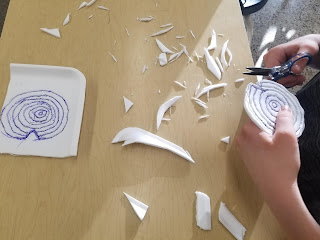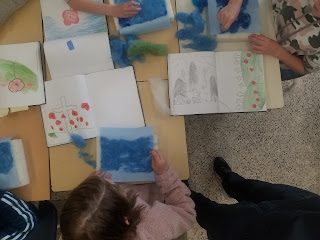The last few weeks we have been working on our Trees and Forest Science project. We have drawn different plants and trees across Canada to make a scene. In our project we’re able to peel back the layers to show what is behind or inside of the forest. As an example, when you peel back the Understory layer you can see the inside of the trees, as well as squirrels, birds and bugs living as part of the ecosystem. On the back of the cover we are including notes from our research on the layers in different styles and showing what we've learned. This project is to represent and conclude the learning in Trees and Forests.
In class we have been learning about tree cookies and how they show their stories by what their rings look like over the years. Afterwards we got pieces of styrofoam and a pen and then started to carve the styrofoam so we can make prints with ink. It's important to know what is happening to trees in certain areas to help sustain forest areas. Some examples of what you can learn by looking at the rings are injuries, fires, insect infestations, and growing conditions like droughts.
In mathematics we’ve been learning about integers and how we use them in our everyday lives. Integers can be positive and negative numbers. We were asked to make sentences that would include them. You could use them to keep track of your money. For example, if you were to lose $5, the integer would be -$5. If you found $2 on the ground, the integer would be +$2. We are ordering integers on number lines to compare their values using 0 as the middle number. Some of us are even subtracting and adding with negative integers when playing 'War' using a deck of cards.


































